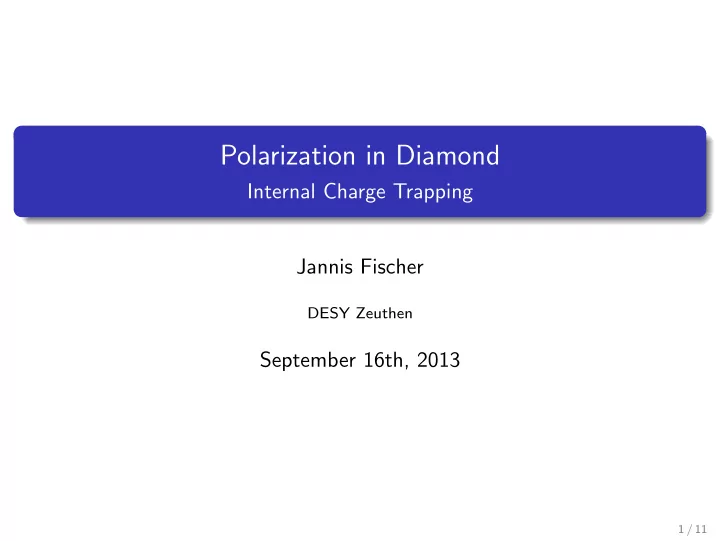

Polarization in Diamond Internal Charge Trapping Jannis Fischer DESY Zeuthen September 16th, 2013 1 / 11
Contents Basic Equations 1 Transport algorithm 2 Result 3 Outlook 4 2 / 11
Trapping mechanisms Traps E C E t , 1 E g E F E t , 2 E V Look at initial, neutral state Traps below E F ≈ E V + E g 2 are filled → Donor-like Traps above E F ≈ E V + E g 2 are empty → Acceptor-like Each trap type described by function f t ( x ) : [0 , d ] → [0 , 1] In initial neutral crystal: f t = 1 for Donor-like, f t = 0 for Acceptor-like Then: f t ( x ) = n T ( x ) N T 3 / 11
Trapping mechanisms Capture/Emission Equations Beginn with Generation/Trapping/Emission rates: Generation: 36 · 10 4 cm − 1 d ∆ x · Φ (Φ: Flux of incoming particles, d : Thickness, ∆ x : cell spacing) Prompt Recombination: Next slide � � 1 − n T ( x ) Trapping: ∆ n T ( x ) = − ∆ n ( x ) = n ( x ) C tr e ∆ t N T ( n T : Trapped electron density, N T : Trap density, n mobile electron density, C tr e = σ n v th , n N T ) Detrapping: ∆ n T ( x ) = − n T ( x ) C em ∆ t e e 10 19 exp ( C em = C tr − ∆ E � � , ∆ E : Depth of Trap) e kT 4 / 11
Trapping mechanisms Prompt Recombination Problem: How to include that some electron hole pairs will immeadiately recombine after generation? Look at CCE measurements of good crystals, use empirical formula Diamond CCEvsHV fit 1,500 SC01013 SC01530 SC01683 1,000 SC01735 SC01756 SC01760 SC01761 A,B,C,D>0 parameters 500 NonLinearFit1 NonLinearFit2 NonLinearFit3 NonLinearFit4 CCE 0 NonLinearFit5 NonLinearFit6 NonLinearFit7 −500 −1,000 −1,500 −600 −400 −200 0 200 400 600 Voltage (V) 5 / 11
Transport Algorithm Steps in Simulation: 1 Generate charges uniformly in crystal, save number of generated charges Q gen 2 Reduce this charge by prompt recombination (dependent on local electric field) 3 Do transport: Start at negative electrode (for electrons) 4 In each cell calculate trapping and emission, change n , n T accordingly 5 Move leftover charge to next bin, count this number of moved charges to Q mov 2Q mov 6 At end of crystal: CCE = N Cells Q gen 7 Do the same for holes in opposite direction 8 Recalculate local electric field from Poisson equation using FEM 6 / 11
Transport Algorithm Parameters Parameter Value 5 · 10 − 2 cm Thickness No. of Cells 100 1000 cm − 2 Incoming Particle Flux 10 15 cm − 3 Trap concentration Temperature 300 K Time step ∆ t 1 s External HV 100 V 1 Trap Energy 4 E g Prompt Recombination: 1 CCE ( E ) = 1 − (1) � � − 5 · 10 − 2 · E − 38 1 + exp 11 7 / 11
Results Charge distribution Trapped Charge Distribution (t=300s) 3e+11 n T p T 2.5e+11 Charge Density / cm -2 2e+11 1.5e+11 1e+11 5e+10 0 0 20 40 60 80 100 Cell No. 8 / 11
Results Electric Field Internal Electric field 1,000 0 −1,000 Electric field / Vcm -1 −2,000 −3,000 −4,000 −5,000 −6,000 −7,000 −8,000 0 20 40 60 80 100 120 Cell No. 9 / 11
Results CCE development CCE vs time 100 90 80 CCE 70 60 50 0 50 100 150 200 250 300 time / s 10 / 11
Outlook Which parameters should be examined first? This should be discussed. 11 / 11
Recommend
More recommend